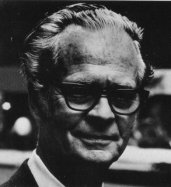
Skinner was an American psychologist and advocate of behaviorism.While at Harvard, Skinner laid the foundation for a new system of behavioral analysis through his research in the field of animal learning, utilizing unique experimental equipment of his own design.
His most successful and well-known apparatus, known as the Skinner Box, was a cage in which a laboratory rat could, by pressing on a bar, activate a mechanism that would drop a food pellet into the cage. Another device recorded each press of the bar, producing a permanent record of experimental results without the presence of a tester. Skinner analyzed the rats' bar-pressing behavior by varying his patterns of reinforcement (feeding) to learn their responses to different schedules (including random ones). Using this box to study how rats "operated on" their environment led Skinner to formulate the principle of operant conditioning-applicable to a wide range of both human and animal behaviors-through which an experimenter can gradually shape the behavior of a subject by manipulating its responses through reinforcement or lack of it. In contrast to Pavlovian, or response, conditioning, which depends on an outside stimulus, Skinner's operant conditioning depends on the subject's responses themselves.
Skinner introduced the concept of operant conditioning to the public in his first book, The Behavior of Organisms (1938). His ideas eventually became so influential that the American Psychological Association created a separate division of studies related to them (Division 25: "The Experimental Analysis of Behavior"), and four journals of behaviorist research were established.
In the 1940s Skinner began training animals to perform complex activities by first teaching them chains of simpler ones. He was quite successful in training laboratory animals to perform apparently remarkable and complex activities. One example of this involved pigeons that learned to play table tennis.
Skinner presented a military officer in the Pentagon with "a guidance system for a missle". It seemed to work perfectly. But the officer rejected it. Why? He discovered that it consisted of two pigeons in the box, each trained to peck at a metal marker when it appeared on its side of the box, thereby keeping the marker in the center for all but a minute fraction of the time.
Skinner devised a box for "raising children" and "raised" his daughter in a "Skinner box". She commiotted suicide at age 20.
Before humans were sent into space, a chimp went into space in a rocket, performing certain tasks to be recorded. This chimp was trained by Skinner. (The chimp is mentioned in the 1983 film, The Right Stuff, about the early history of NASA.)
Skinner's observation of the effectiveness of incremental training of animals led him to formulate the principles of programmed instruction for human students, in which the concept of reward, or reinforcement, is fundamental, andcomplex subjects such as mathematics are broken down into simple components presented in order of increasing difficulty. Presented with a set of relatively simple questions, students receive immediate reinforcement (and thus incentive to continue) by being told that their answers were correct.
The programmed learning movement became highly influential in the United States and abroad. Although this technique eventually came under criticism by educators advocating more holistic methods of instruction, it remains a valuable teaching tool. Courses and course materials based on it have been developed for many subjects, and at levels of difficulty ranging from kindergarten through graduate school.
(I wrote my own programmed instruction for use in my mathematics courses, not because of the idea of operant conditioning, but to allow each student to work at her or her own pace. The best students, not held back by others, finished two or three semester's work in one semester. Slow or unprepared students, not pushed out still partially unprepared, might take two or three semesters to finish the work -- tested by "Standard Tasks" shown on blakpage.htm -- learning it all. When a new President for our University forced me to return to conventional methods, I had to drop 50% on the material covered in the "Introductory" course.)
Skinner became better known to the general public by publication in 1946 of Walden Two, a new utopian-commune run on Skinner's operant principles. This influenced many "hippie" communes of the 60's and 70's, and the name of the college in the Doonsbury comic strip by Gary Trudeau.